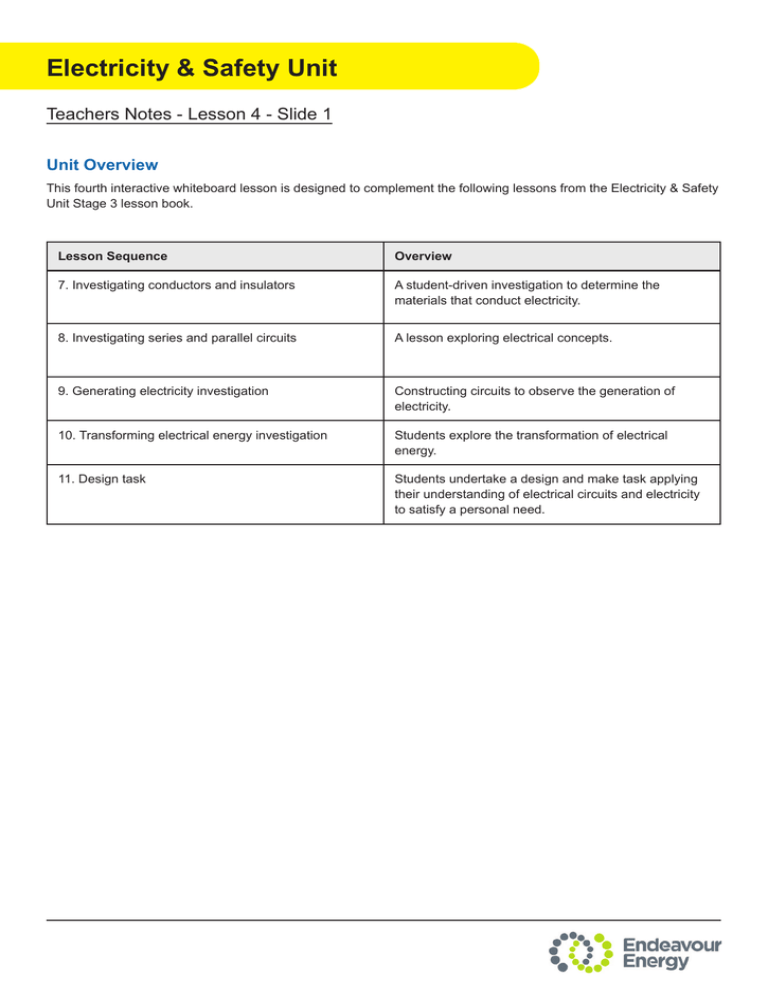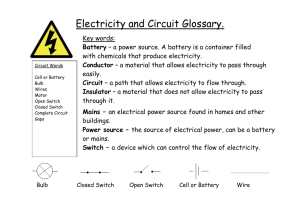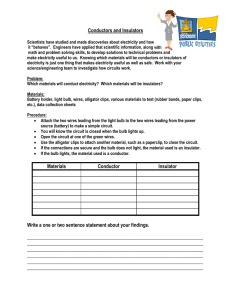Lesson 4 - Endeavour Energy Electric Kids
advertisement

Electricity & Safety Unit Teachers Notes - Lesson 4 - Slide 1 Unit Overview This fourth interactive whiteboard lesson is designed to complement the following lessons from the Electricity & Safety Unit Stage 3 lesson book. Lesson Sequence Overview 7. Investigating conductors and insulators A student-driven investigation to determine the materials that conduct electricity. 8. Investigating series and parallel circuits A lesson exploring electrical concepts. 9. Generating electricity investigation Constructing circuits to observe the generation of electricity. 10. Transforming electrical energy investigation Students explore the transformation of electrical energy. 11. Design task Students undertake a design and make task applying their understanding of electrical circuits and electricity to satisfy a personal need. Investigating conductors & insulators Teachers Notes - Lesson 4 - Slide 2 Investigating Conductors and Insulators Task: Identify materials that conduct electricity and insulate electricity. A hands-on student driven investigation to explore and determine the materials that conduct electricity. Teacher Background Information If an electric charge can easily flow through something, that something is referred to as a conductor. Most metals are considered conductors of electricity. Water is also a good conductor of electricity and that means so is the human body. Since our bodies are made up mostly of water, electricity can easily move through our bodies on its way to the ground. If an electrical current cannot easily pass through an object, that object is called an insulator. Most nonmetallic items, like rubbers and plastics, are considered insulators. Electricity travels at the speed of light, so if a person comes in contact with electricity he/she will feel the electrical jolt immediately. Electric current flowing through your body can cause damage to your nerves and tissues, so it’s important to be very careful around electricity. Assessment Formative assessment – monitoring students’ learning and developing understanding via observation and providing feedback to extend learning Equipment • Role badges used in Lesson 4 • Each team member’s SciTech journal • 1.5 volt battery • Light bulb and lamp holder • Multimeter (if available, but not essential for experiment) • 3 connecting wires • Variety of items for testing, e.g. paper-clips, aluminium foil, rubber band, string, texta, wooden ruler and other classroom items Activity steps: • Discuss with students how we know that electrons are flowing in a circuit. • Ask students how they could test different materials for electrical conductivity. • Guide students to suggest constructing an open circuit that includes a battery, wires and a light bulb. The items being tested should then be used to complete the circuit. If the light glows, then the material is a conductor of electricity. • Discuss with students: • The idea of a “fair test”. • How can we ensure that the test is fair? • What variables must we keep the same? (length of wires, same battery, etc.) • How will we record our observations? Investigating conductors & insulators Teachers Notes - Lesson 4 - Slide 2 • Have students construct a table in their SciTech journal with a list of approximately ten objects in the left hand column. Have them predict conductivity. Example shown below: Object Material Paper-clip steel Plastic ruler plastic Prediction: Will it conduct Does the light bulb glow? electricity? Yes/No • Divide class into groups, assign roles and hand out badges. • Ask Lab Technicians to collect equipment. • Ask each group to make a prediction about which materials will conduct electricity. • Have students construct an open circuit. • Ask students to test their circuit by using the object to complete the circuit. If the light globe glows then the object is a conductor of electricity. If the object did not allow the light to glow then it is an insulator. • Have students test the provided objects. Ensure students record their observations. • Have students present their findings to the class. • List the conductors and insulators. • Is there a pattern in the results? • Was the outcome different to their predictions? • Do the results support their prediction? • What difficulties did they experience when completing this investigation? • How could they improve this investigation? • Have students suggest reasons why electrical wires are coated in plastic. Why should frayed electrical cords be replaced? • Discuss: • Why is it useful to know which materials conduct electricity? • Will the human body conduct electricity? What injuries may happen to a person who has received an electric shock? Extension Activity • Ask the students to design their own switch. The switch must be safe and able to be switched on and off repeatedly. • In groups students draw a labelled diagram of their design. • Students construct and present their designs to the class. • Students discuss the safety features incorporated in their designs and how their design could be improved. Investigating series and parallel circuits Teachers Notes - Lesson 4 - Slide 5 Task A: Creating a series circuit and a parallel circuit A student driven, hands-on investigation to observe light bulbs connected in a series and parallel circuit. This lesson will explain and develop scientific explanations for observations. Assessment Formative assessment – monitoring students’ learning and developing understanding via observation and providing feedback to extend learning. Equipment • Role badges used in Lesson 4 • Each team member’s SciTech journal • 2 x 1.5 volt battery • 1 light bulb • 2 connecting wires Activity steps • Review previous session about exploring electrical circuits, refer to word wall and KWL chart. • Ask the students what they know about series circuits and parallel circuits. • Ask students what they think these terms could mean and what these circuits would look like. • Students discuss and share what they would like to find out about series and parallel circuits and add to KWL chart • Divide the class into groups, assign roles (Chief Scientist, Safety Officer, Lab Technician, Science Journalist and Science Communicator) and hand out the role badges • Ask Lab Technicians to collect equipment • Students construct a closed circuit that includes 1 battery, 2 wires and a light bulb. • Ask the students to place a dark coloured card behind the light bulb and observe its brightness. • Students repeat step 1 using 2 batteries connected in series. • Discuss with students what they observed and have students suggest explanations for their observations. • Have students construct a closed circuit that includes 2 batteries set in parallel, 2 wires and a light bulb. • Place a dark coloured card behind the light bulb and compare the brightness of the light bulb with the previous circuit. • Ask students to place a third battery in parallel and compare the brightness of the light bulb. • Discuss with the class: • Did the additional battery make the bulb glow brighter? • What do you think is happening to the flow of electrons in a series and parallel circuit? Investigating series and parallel circuits Teachers Notes - Lesson 4 - Slide 5 Task B: Investigating the voltage in a series circuit and a parallel circuit A student driven, hands on investigation to determine the voltage in a series and parallel circuit. This lesson will explain and develop scientific explanations for observations. Assessment Formative assessment – monitoring students’ learning and developing understanding via observation and providing feedback to extend learning. Equipment • Role badges used in Lesson 4 • Each team member’s SciTech journal • 2 x 1.5 volt battery • Multimeter Activity steps • Review previous sessions (series and parallel circuits), refer to word wall and KWL chart. • Ask the students what they know about the way electricity is measured. • Introduce the term volts and discuss • Explain and demonstrate the use of the multimeter to the students. • Have the students predict whether increasing the number of batteries will increase the voltage. • Ask the students to conduct an investigation to test their prediction • Divide the class into groups, assign roles (Chief Scientist, Safety Officer, Lab Technician, Science Journalist and Science Communicator) and hand out the role badges Type of circuit Number of batteries Multimeter reading (DCV)/(DCA) One battery Series Two batteries Three batteries Parallel Four batteries Five batteries • Ask Lab Technicians to collect equipment • Students reconstruct their series and parallel circuits, replacing the light bulb with the multimeter to complete the Investigating series and parallel circuits Teachers Notes - Lesson 4 - Slide 5 circuit. • Students construct a table to record their observations in their SciTech Journals (sample below). • Using a multimeter students measure record and compare the voltage and amps of each circuit. • Students construct a graph using the collected data. • Discuss with students what type of graph would best represent the data in a way that best addresses their prediction. • What labels must they include on the X and Y axis? • Once students have constructed their charts discuss the results and construct a statement summarising what they have learnt about batteries set in series and parallel circuits. Add the statements to the KWL chart and any new words should be added to the word wall. Extension Activity Ask students to predict what may happen to the brightness of 2 bulbs if they were placed in series. Ask students to predict what may happen to the brightness of 2 bulbs if they were placed parallel. Transforming electrical energy investigation Teachers Notes - Lesson 4 - Slide 7 Task: Constructing circuits to observe the transformation of energy A lesson to explain the transformation of electrical energy by developing scientific explanations for observations. Teacher Background Energy cannot be destroyed, but rather transformed, e.g. the sun’s energy is used by plants to grow and produce fruit, humans then consume the fruit which can be used to maintain our body temperature and allows us to move, walk or run. Assessment Formative assessment – monitoring students’ learning and developing understanding via observation and providing feedback to extend learning Equipment • Role badges from Lesson 4 • Each team member’s SciTech journal • 1.5 volt batteries • Light bulb • 2 Connecting wires • Electric motor • Buzzer Transforming electrical energy investigation Teachers Notes - Lesson 4 - Slide 7 Activity steps • Review previous sessions on circuits • Discuss with students the concept that energy cannot be destroyed • Ask students if they are aware of any other transformations of energy. • Students discuss and share what they would like to find out about the transformation of energy and add to KWL chart • Divide the class into groups, assign roles (Chief Scientist, Safety Officer, Lab Technician, Science Journalist and Science Communicator) and hand out the role badges • Ask Lab Technicians to collect equipment • Students construct a closed circuit that includes 1 battery, 2 wires and a light bulb. • Ask students how they think electrical energy transformed in the light bulb? • (Electrical energy is transformed to light making the light bulb glow and heat.) • Ask students to lightly touch the light bulb. • What can they feel? – Heat. • Students draw and label a diagram of their circuit indicating the transformation of electrical energy • Students replace the light bulb in their circuit with a buzzer. • How is the electrical energy transformed? (Electrical energy is transformed to sound and heat.) • Students draw and label a diagram of their circuit indicating the transformation of electrical energy. • Students replace the buzzer in their circuit with an electric motor. • Ask how the electrical energy transformed. • (Electrical energy is transformed to movement, sound and heat). • Students draw and label a diagram of their circuit indicating the transformation of electrical energy. How does a fuse work? Teachers Notes - Lesson 4 - Slide 12 Teacher Demonstration This flash activity provides students with a visual demonstration of how a fuse works. Suggested activity steps are outlined below: Activity steps • Revise open and closed circuits with students. • Discuss what may happen to wires if too much electric current flows through them. • Wires could melt and may cause a fire. • Begin the flash activity and ask students to observe what happens. • Connect the wires to each end of the fuse wire to close the circuit. • Discuss: • What happened to the fuse wire? • Have students suggest: • an explanation for their observation (too much electricity flowing through the fuse wire). • Have students draw and label a diagram of the virtual experiment. • Discuss: • Ask students to explain the simile “a fuse is like an electrical watch dog.” • Why should you not plug too many appliances into a wall socket? • Most modern houses have circuit breakers or safety switches. Research one of the devices. Design task Teachers Notes - Lesson 4 - Slide 13 Task: Students demonstrate understanding gained through a scientific investigation by resolving a design brief. A task for students to design and make a product that uses the ‘transformation of electrical energy’ as an essential feature of its design. The final phase provides an opportunity for students to evaluate and reflect on their own learning, new understandings and development of skills. Assessment Summative assessment of the science inquiry skills. Explore and define Define purpose of the product, develop criteria and find out what is currently available. Design brief • Students design and make a product that transforms electrical energy and solves a personal need. • Students should consider: • What products exist that address similar problems or needs? How do they work? • What resources are available to construct our product? • How will they test and evaluate their design solution? • How they will manage the time available to develop the product? • Is there a ‘technical expert’ who can provide assistance? • Are there electrical safety issues? Generate and develop ideas • Students sketch initial ideas for their product and annotate their sketch to explain how the product works. • Remind students to consider the circuit required to operate the product. • Students identify the need addressed by the product or the system, and the energy transformations involved in its operation. • Suggestions of problems which could be solved with the design of a product: • My little brother reads my diary. • Everyone barges into my room. I have no privacy. • I like reading in bed at night but the light disturbs my little sister • We get very hot in our tree house. • The mosquitoes always bite me when I am in the garden. • How can I make a game that keeps my younger brother/sister amused? Design task Teachers Notes - Lesson 4 - Slide 13 Produce Solutions • Ensure that students understand that their product must be housed in a suitable casing. Discuss what functions the casing must perform, e.g. hold the circuit in place, hold the working parts, protect the product from dirt and damage, be easy to handle, be aesthetically pleasing and convey information about the operation of the product. Provide students with a wide range of materials that can be used to complete the product e.g. paddle pop sticks Product Home security alarm Need / Purpose Warn off intruders Dissuade intruders Energy transformations Sensor (light/sound energy) > electrical energy > sound energy Protect people and property Vacuum cleaner Remove dust and dirt Remove dust mites that cause allergies Electrical energy > mechanical energy Stove Heat or cook food Electrical energy > heat energy Solar garden lights Provide lighting for paths Light energy > electrical energy > chemical energy (battery) > electrical energy > light energy Provide security Increase enjoyment of garden Evaluate • Ask students to evaluate the design against the design brief and consider the effectiveness of the process • Provide students with questions to be used when reflecting on their task • What part of the task was most enjoyable? • What part of the task was least enjoyable? • What did you learn? • What part of the learning was most important? Why is it important? • If you were to undertake the task again, what would you do differently and why? Design task Teachers Notes - Lesson 4 - Slide 16 Aim of this flash activity: • Show students the design elements of a torch • Show students how an electrical circuit may work in a torch • Gets students thinking about designing their own product Teachers Notes - Lesson 4 - Slide 17 Aim of this flash activity: • Show students the design elements of a home door bell system • Show students how an electrical circuit may work in a door bell system • Gets students thinking about designing their own product




